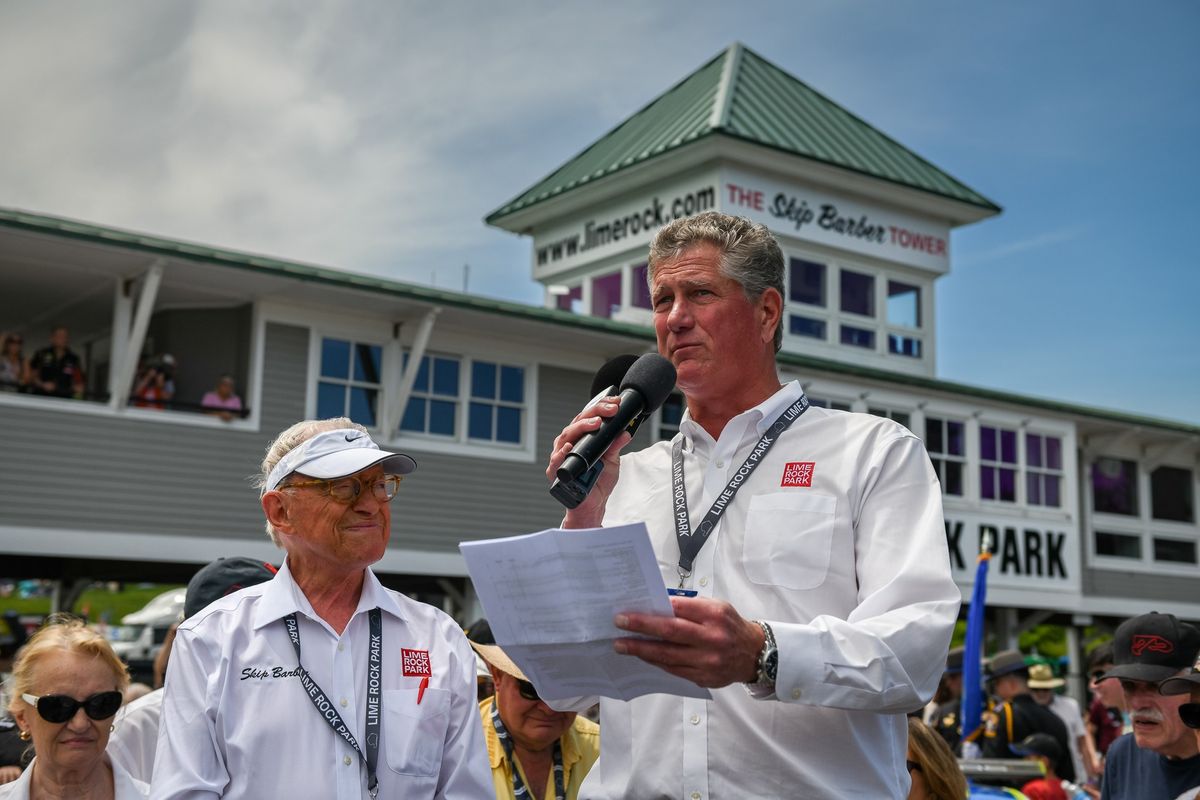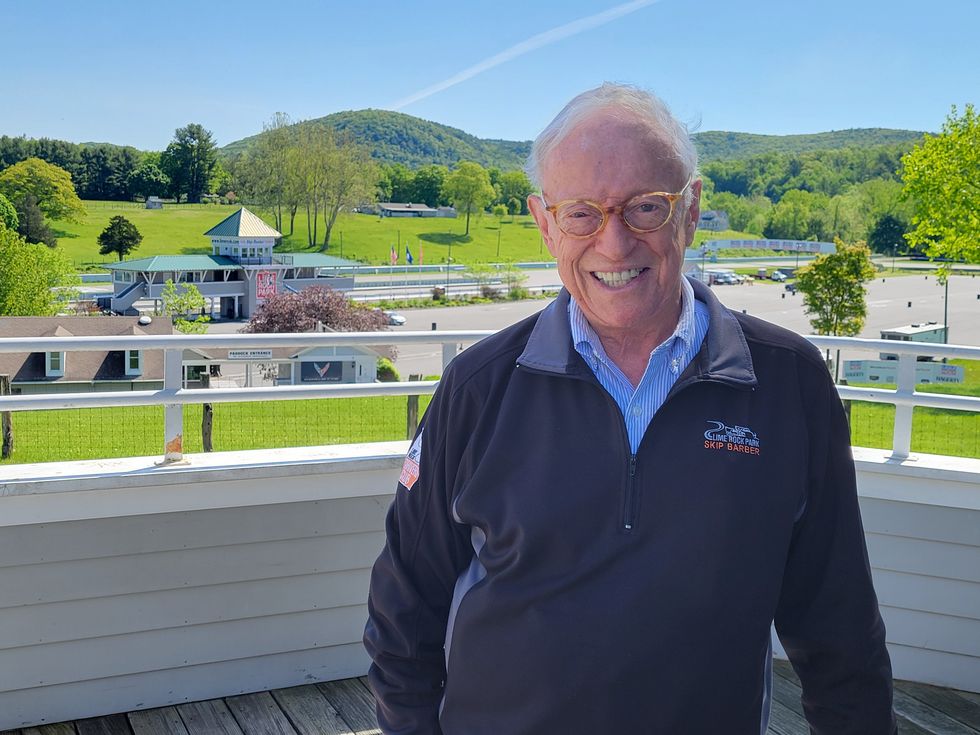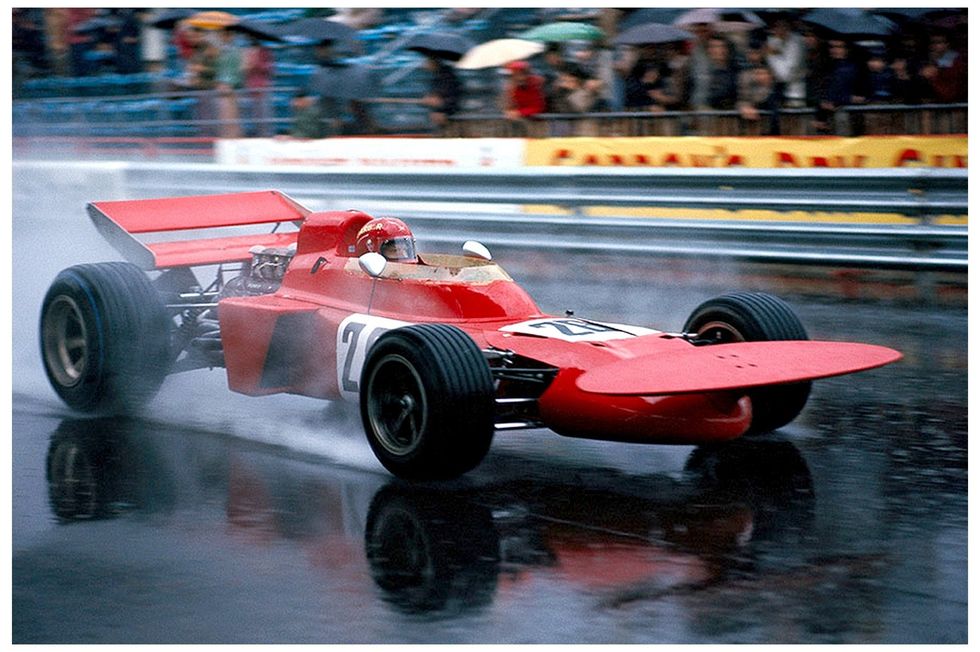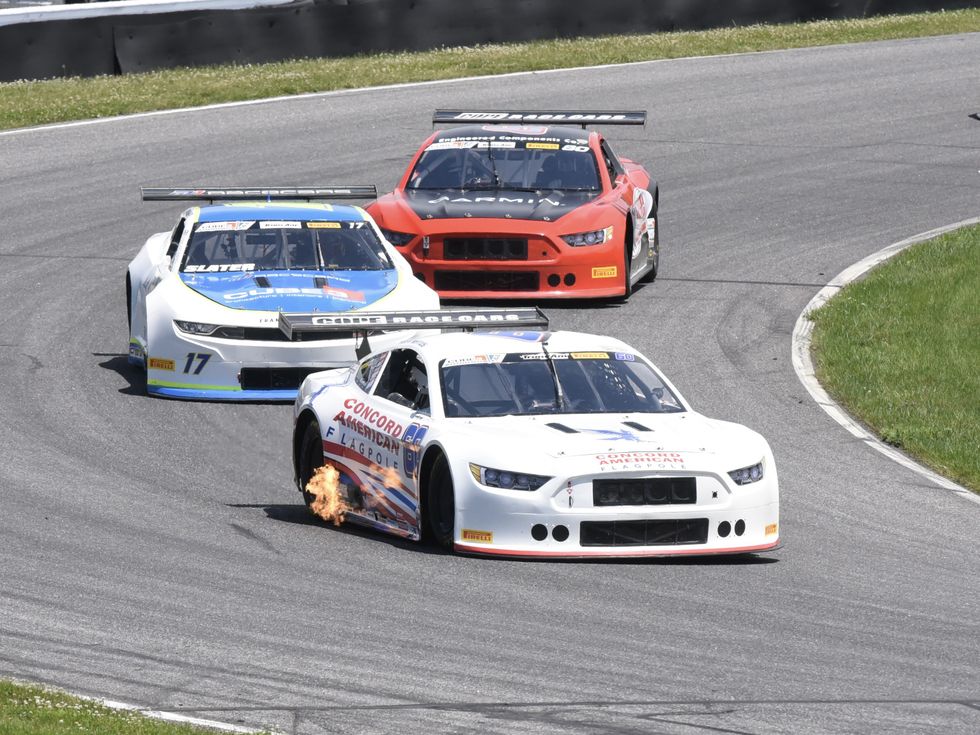‘Hero of Horsepower’ Barber shaped Lime Rock’s history

Lime Rock Park CEO Dicky Riegel, right, introduced Skip Barber, at left, during the May 25 dedication of the newly christened Skip Barber Tower.
Shawn Pierce

Lime Rock Park CEO Dicky Riegel, right, introduced Skip Barber, at left, during the May 25 dedication of the newly christened Skip Barber Tower.
LIME ROCK — Skip Barber’s affinity for racing took root at the tender age of 10 in a block-long alley behind his family’s Philadelphia home.
Propped up on a pillow to help him see over the wheel and reach the pedals of a dusty old Ford that had been stored in the garage, the youngster was only allowed to drive it back and forth in the narrow alley. There was no room to turn around.
“I logged exactly as many miles going backwards as I did going forward,” recalled the soft-spoken Barber, who had grown up in a family of automobile enthusiasts. His grandfather owned an auto dealership, and his dad had an interest in cars.
Little did he know that those countless miles logged in that alley in 1946 would lead to his status as an enduring legacy in American motorsports and an icon at Lime Rock Park (LRP), which has declared 2024 as “The Year of Skip Barber.”
As Barber, who sold the majority of the park to Lime Rock Group LLC in 2021, marks the 65th anniversary of his first visit, and first race, at the Lakeville track, the park is paying tribute to him throughout the season through special events, exhibitions and commemorative merchandise.
“As Lime Rock Park celebrates its 67th year of operation it does so with a deep sense of gratitude and reverence for the man whose vision and passion have left an indelible mark on this iconic racetrack,” said Dicky Riegel, LRP President and CEO, of the park’s former owner and founder of the world-renown racing school which bears his name.
“His commitment to excellence and his relentless pursuit of innovation have earned him the respect and admiration of his peers and racing fans,” Riegel said of Barber, who remains a large shareholder in LRP. “The Year of Skip Barber is a fitting tribute to a man whose passion for motorsport knows no bounds.”
On Saturday, May 25, Barber saw his name carry even more significance in the sport as the track dedicated the timing and scoring tower in his name, after which he served as the Grand Marshal for the popular Trans Am Memorial Day Classic.
For decades, said Riegel, Barber has been a guiding force, instilling a passion for racing in countless individuals and leaving an indelible mark on the racing community. “Now the Skip Barber name will live on in perpetuity, ensuring that he continues to overlook Lime Rock Park for decades to come.”

‘I think car racing saved me’
From his early days as a competitive racer to his later years as a respected mentor, Barber’s career has been defined by a relentless pursuit of greatness. His eponymous Skip Barber Racing School, founded in 1975, became a mecca for aspiring racers, providing them with the tools and knowledge needed to succeed on and off the track.
During a mid-May interview in a cozy chalet overlooking the picturesque park, Barber, 88, reflected on his journey in racing which began long before he became a household name.
An exceptional student throughout high school, he earned a full scholarship to Harvard. He would have been an English major but his need for speed won out over his desire to study.
“I think car racing saved me. I had good grades in high school and got a complete scholarship to Harvard. And then I didn’t do any work. I really checked out. During that time, I started reading car magazines and I got more and more interested. I decided to take my senior year off, and my housemaster said, ‘Excellent idea, go ahead,’” Barber said with a laugh.
He joined the Merchant Marine to earn some cash and pooled his resources “with a little money from my mother to buy my first race car, an Austin-Healey Bugeye Sprite, the cheapest car in the world.”
Back at Harvard a year later, Barber attended the Sports Club Car of America (SCCA) driver’s school at Marlboro, near Washington, D.C., and raced his first race. That race, he recalled, was at Lime Rock Park. Not only was this his first time visiting a racetrack, it was also his first win and the beginning of what would become a decades-long love affair with the Lakeville track and the Northwest Corner.
Little did he know at the time that this would be the start of a remarkable career that would not only shape his own legacy but also transform Lime Rock Park into one of the premier racing destinations in the world.

Shining moments in the driver’s seat
Barber, who resides in Sharon with his wife, Judy, raced a variety of machinery in the 1960’s and 1970’s, ranging from sports cars to high-powered formula cars. He delivered some shining moments while in the driver’s seat, including beating Jim Clark in an identical car at the then Mosport in his first professional race and setting the ultimate lap record at Lime Rock Park to help push his name to the top of call sheets.
Along the way, he won three Sports Car Club of America (SCCA) National championships, set 32 different lap records, and earned the President’s Cup. Barber was only beginning to build a lasting legacy in American motorsports.
Barber explained how he drove cars the owners or manufacturers wanted to sell.
“It was a great opportunity, and I was very fortunate. The affordable part about racing is what we call ‘getting a ride,’ that’s when someone else is providing you with something to drive,” he explained. The downside, he said, was that he was “completely dependent on other people providing me with the tools of my trade. I was great on the racetrack, but I wasn’t very good at getting the rides” and networking.
At that time, the guru of track racecar engineering in North America, Carrol Smith, referred to Barber as “the fastest guy who never made it big.”
It wasn’t until years later when he started his racing school, that he would become a good marketer, Barber explained, “but that was too late for racing.”

Skip Barber Racing School
Although he was “hoping it would never stop,” Barber said he finally realized that his racing days were coming to a halt.
“I had the idea of doing a racing school. It’s not that there weren’t some in the country. There was one in L.A., and another near Montreal, but I did not know about them.”
Believing that racing was a coachable sport, Barber formed the Skip Barber Racing School in 1975 at Lime Rock and Thompson Speedway with four students and a pair of borrowed Formula Fords. During this time, Barber served as president of the Road Racing Driver’s Club.
Recognizing the key role that Lime Rock Park could play in building his growing racing school, and to keep the track out of the hands of developers in the high-value Northwest Corner countryside, Barber led a group of investors, all racing school graduates, who purchased the track from Harry Theodoracopulos in 1983, eventually becoming the sole owner.
His eponymous school created champions in every professional racing series in the United States and produced winning drivers at the Indy 500 or Daytona 500 for decades. Barber sold his school in 1999 and continued to work there until 2001.
“I was told by the current owners that 400,000 students, from all over the country, have become racers and champions,” said Barber.
Graduates include Marco Andretti, Ryan Hunter-Reay, Alexander Rossi, Danica Patrick, AJ Allmendinger, Juan Pablo Montoya, Jeff Gordon and hundreds of other top professional racers today.
“You get big by having multiple schools going all at the same time. We had an office in Lakeville, and the workshops were in four different locations. Lime Rock was our most important track of all the tracks used around the country. It certainly was my favorite,” said Barber.
In 2021, Barber sold the track to Lime Rock Group LLC, a group of investors whom he said were equally passionate about carrying out Lime Rock Park’s legacy into the future. “This is a good group,” he said. “They feel the same way about it as I do.”
These days, Barber said he is happy with his continuing relationship as a large shareholder in Lime Rock Group LLC and his role as an active track management team member. After decades at the helm of Lime Rock Park, including some tumultuous years securing its future, Barber said he now has peace of mind.
“I’m no longer in charge of worrying.”
A Hero of Horsepower
In late April, the Motorsports Hall of Fame of America announced its 2025 Induction Class, which recognized Barber as the founder of “the driving school of champions” in the category of Sports Cars along with six other “Heroes of Horsepower” inductees.
The Class of ’25 will formally be presented into the Hall of Fame in Daytona Beach, Fla., on March 10 and 11, 2025.
As he wrapped up the interview, Barber stepped out onto the Chalet’s terrace and viewed the expansive, verdant park and beamed with happiness — and a look of incredulousness. “I am so in awe of its beauty. To think that I’ve owned this…”
HVRHS’s Victoria Brooks navigates traffic on her way to the hoop. She scored a game-high 17 points against Nonnewaug Tuesday, Dec. 16.
FALLS VILLAGE — Berkshire League basketball returned to Housatonic Valley Regional High School Tuesday, Dec. 16.
Nonnewaug High School’s girls varsity team beat Housatonic 52-42 in the first game of the regular season.
The atmosphere was intense in Ed Tyburski Gym with frequent fouls, traps and steals on the court. Fans of both sides heightened the energy for the return of varsity basketball.
HVRHS started with a lead in the first quarter. The score balanced out by halftime and then Nonnewaug caught fire with 20 points in the third quarter. Despite a strong effort by HVRHS in the last quarter, the Chiefs held on to win.
Housatonic’s Victoria Brooks scored a game-high 17 points and Olivia Brooks scored 14. Carmela Egan scored 8 points with 14 rebounds, 5 steals and 4 assists. Maddy Johnson had 10 rebounds, 4 steals, 2 assists and 2 points, and Aubrey Funk scored 1 point.
Nonnewaug was led by Gemma Hedrei with 13 points. Chloe Whipple and Jayda Gladding each scored 11 points. Sarah Nichols scored 9, Bryce Gilbert scored 5, Gia Savarese scored 2 and Jazlyn Delprincipe scored 1.
CORNWALL — At the Dec. 9 meeting of the Planning and Zoning Commission, the commission had a pre-application discussion with Karl Saliter, owner of Karl on Wheels, who plans to operate his moving business at 26 Kent Road South, which is an existing retail space.
Saliter said he will use the existing retail section of the building as a mixed retail space and office, and the rear of the building for temporary storage during moving operations.
There will be no external “personal” storage proposed for the property.
The commission decided that Saliter should go ahead with a site plan application under the regulations for “retail stores and trades.”
P&Z also set a public hearing on a proposed text amendment on dimensional requirements for properties in the West Cornwall General Business (GB) zone. It will be held Jan. 13, 2026, at 7 p.m. at the Cornwall Library.
FALLS VILLAGE — The Board of Selectmen at its Dec. 17 meeting heard concerns about the condition of Sand Road.
First Selectman David Barger reported a resident came before the board to talk about the road that is often used as feeder between Salisbury and Canaan.
“The person said there is not proper maintenance of that road and it is often the scene of accidents,” Barger said in a phone interview. “There is a problem with the canopy of trees that hang over it, making it hard to keep clear, but there is also the problem of speeding, which is terrible.”
As a former state trooper, he said he is familiar with the problem of drivers going too fast on that road, describing one case in which he had to charge someone for traveling way above the speed limit.
Barger said the town cannot reconfigure the roadway at this time, but officials and road crew members will keep an extra eye on it as a short-term solution.
In other business, Barger said the selectmen plan to call a town meeting sometime next month. Residents will be asked to take the remaining funds, which total $48,200, from the non-recurring capital fund to allow for Allied Engineering to perform engineering studies on the proposed salt shed. Money for construction has already been secured through a STEAP grant, which the town received in the amount of $625,000.
“We’re looking at critical infrastructure projects and this is one component,” he said.
At that town meeting, there will also be a vote to take $2,000 from the town’s discretionary fund to pay Cardinal Engineering for work on repair of the Cobble Road bridge.